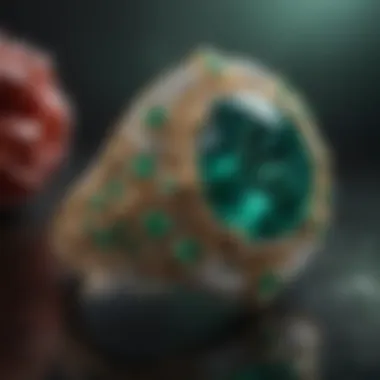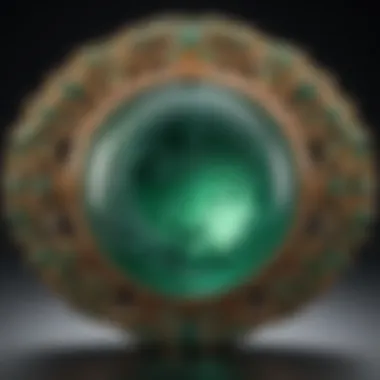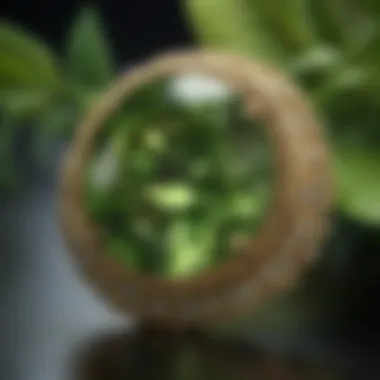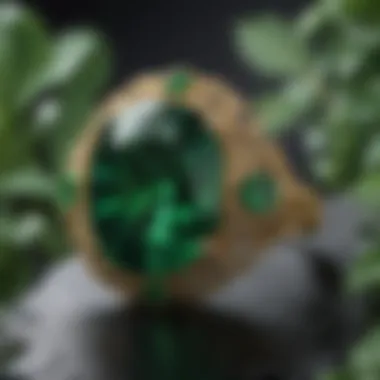Unveiling the Enigmatic Beauty of Green Gemstones: Emeralds, Jades, and More


Overview of Gemstones and Minerals
Green gemstones have long held a mystical allure that transcends mere aesthetic appeal. The enchanting world of green gemstones encompasses a diverse array of precious stones, each with its own unique properties and cultural significance. From the mesmerizing allure of emeralds to the serenity exuded by jades, these treasures of nature have captivated humanity for centuries, offering not only beauty but also a glimpse into the wonders of the earth's depths.
History of Gemstone and Mineral Use
Throughout history, gemstones and minerals have played integral roles in various civilizations. Green gemstones, in particular, have been revered for their association with nature, fertility, and prosperity. Ancient cultures believed that these stones possessed mystical powers, providing protection and wisdom to those who wore them. From the emerald mines of Cleopatra to the sacred jades of the Far East, the history of green gemstones is steeped in legend and lore, making them coveted symbols of wealth and spirituality.
Significance in Culture and Society
The significance of green gemstones extends beyond their monetary value; they are embedded in the cultural fabric of societies worldwide. In many traditions, emeralds symbolize hope, rebirth, and growth, while jades are revered for their ability to instill peace and balance. These gemstones have been prominently featured in royal adornments, religious artifacts, and medicinal practices, illustrating their enduring influence on art, spirituality, and holistic healing.
Gemstone Formation and Properties
The formation process of green gemstones is a mesmerizing journey that spans millennia. From the metamorphic pressures that create the vivid green hues of emeralds to the mineral compositions that give jades their signature tranquility, each gemstone undergoes a unique transformation deep within the earth's crust. These gemstones are defined by their impeccable clarity, vibrant color, and distinct luster, stemming from the geological conditions that mold them into nature's exquisite creations.
Formation Process of Gemstones
Green gemstones form through a combination of geological processes, including heat, pressure, and mineral deposits. Emeralds, for instance, are born in hydrothermal veins where beryllium and chromium interact under immense pressure, resulting in the formation of the characteristic green crystals. Jades, on the other hand, originate from metamorphic rocks rich in sodium and aluminum, gradually transforming into the smooth, translucent stones revered for their calming energy.
Properties that Define Gemstones
What sets green gemstones apart are their inherent properties, each contributing to their enchanting allure. Emeralds are prized for their vibrant green color, which is due to trace amounts of chromium within the crystal structure. Jades, on the other hand, are valued for their toughness and durability, rendering them ideal for intricate carvings and symbolic jewelry. These properties not only enhance the aesthetic appeal of green gemstones but also elevate their cultural and spiritual significance.
Classification based on Color, Hardness, and Luster
Green gemstones are classified based on a myriad of factors, including color, hardness, and luster. Emeralds, with their rich green hue, fall under the beryl mineral group and are valued for their high degree of hardness on the Mohs scale. Jades, classified as either nephrite or jadeite, boast varying degrees of translucency and luster, further enhancing their mystique and desirability in the world of gemstones.
Types of Gemstones
The realm of green gemstones spans a wide spectrum of varieties, from precious to semi-precious, each offering a distinct charm and appeal. As collectors and enthusiasts delve into the world of green gemstones, they encounter a treasure trove of options that cater to every taste and preference.
Precious vs. Semi-Precious Gemstones
In the realm of green gemstones, the distinction between precious and semi-precious is blurred, with each stone possessing its own inherent value and beauty. While emeralds are traditionally classified as a precious gem, jades hold their own allure as semi-precious stones revered for their cultural significance. This distinction reflects the diverse nature of green gemstones and the multifaceted ways in which they enrich the world of jewelry and adornment.
Common Gemstone Varieties
Within the realm of green gemstones, a myriad of common varieties exists, each showcasing the natural splendor of the earth. From the deep green hues of peridot to the mesmerizing patterns of malachite, green gemstones offer a visual feast for the senses. These common varieties cater to a range of budgets and preferences, ensuring that every enthusiast can find a green gemstone that resonates with their aesthetic sensibilities.
Exotic and Rare Gemstones
For the discerning collector or connoisseur, exotic and rare green gemstones hold a special allure, offering a glimpse into the depths of nature's treasure troves. Gems like alexandrite, with its color-changing properties, or moldavite, formed from extraterrestrial impacts, epitomize the exotic and rare nature of certain green gemstones. These stones are prized not only for their scarcity but also for the unique stories they carry, adding an element of intrigue to any collection.
Identifying and Evaluating Gemstones
The process of identifying and evaluating green gemstones is a meticulous art that requires a keen eye for detail and a deep understanding of mineralogy. Gemstone enthusiasts and professionals alike rely on a range of factors to assess the quality and value of these precious stones, ensuring that each gem is recognized for its unique characteristics and beauty.


Factors Affecting Gemstone Value
Several factors contribute to the value of green gemstones, ranging from color intensity and clarity to carat weight and market demand. Emeralds, for example, are prized for their vivid green hue and lack of inclusions, which can significantly impact their market value. Jades, on the other hand, are evaluated based on translucency, texture, and color uniformity, factors that determine their desirability in the eyes of collectors and aficionados.
Techniques for Gemstone Identification
Gemologists and jewelers employ a variety of techniques to identify green gemstones, utilizing tools such as loupes, refractometers, and spectrometers to analyze their optical and physical properties. By examining factors like refractive index, specific gravity, and internal characteristics, experts can distinguish between different gemstone varieties and confirm their authenticity with precision and accuracy.
Assessing Gemstone Quality
Assessing the quality of green gemstones involves a thorough evaluation of their color, cut, clarity, and carat weight, known as the 4C's of gemstone grading. Whether appraising an emerald's deep green saturation or assessing the smoothness of a jade's surface, professionals use standardized criteria to determine the overall quality and value of each gemstone. This process ensures that collectors and consumers alike can make informed decisions when acquiring green gemstones for their personal or professional collections.
Caring for Gemstones
Proper care and maintenance are essential to preserving the beauty and brilliance of green gemstones for generations to come. Whether you own an exquisite emerald ring or a delicate jade pendant, following best practices for cleaning, storing, and preserving these precious stones is crucial to protecting their integrity and longevity.
Cleaning and Storing Gemstones Properly
To ensure the lasting radiance of green gemstones, it is vital to clean them regularly using mild soapy water and a soft brush or cloth. Avoid harsh chemicals or abrasive materials that can damage the stone's surface or setting. When not in use, store your gemstones in a fabric-lined jewelry box or pouch to prevent scratches and minimize exposure to sunlight, moisture, and extreme temperatures.
Avoiding Common Mistakes in Gemstone Care
Despite their durability, green gemstones are not immune to potential damage from careless handling or improper maintenance. Avoid exposing your gemstones to household chemicals, perfumes, or cosmetics that can cloud their brilliance or alter their color over time. Refrain from wearing gemstone jewelry during activities that may subject them to impact or pressure, minimizing the risk of chips, scratches, or fractures that can diminish their beauty and value.
Preservation Tips for Specific Gem Types
Some green gemstones, such as pearls and opals, require specialized care due to their unique compositions and structures. For pearls, gentle cleaning with a soft cloth and avoidance of direct contact with lotions or cosmetics are essential to maintain their luster and iridescence. Opals, known for their sensitivity to heat and moisture, should be stored in a cool, dry environment away from direct sunlight to prevent cracking or crazing. By following these preservation tips for specific gem types, you can safeguard the timeless beauty of your green gemstones and treasure them for years to come.
Introduction to Green Gemstones
Understanding the Fascination with Green Gems
Symbolism of Green in Gemology
The symbolism of green in gemology is a complex and intriguing aspect that adds depth to the overall allure of green gemstones. Green symbolizes nature, growth, and harmony, reflecting the life force and vitality of the earth. In gemology, green signifies balance and renewal, making green gemstones a popular choice for those seeking harmony and positivity in their lives. The lush green hues of these gemstones evoke a sense of tranquility and connection to the natural world, making them highly desirable for their symbolic connotations.
Historical Significance of Green Gemstones
The historical significance of green gemstones dates back centuries, with various civilizations attributing mystical powers and virtues to these precious stones. Green gemstones were believed to offer protection, prosperity, and healing properties, leading to their prominent use in ancient rituals and ceremonies. The historical importance of green gemstones is a testament to their enduring appeal and timeless beauty, making them a prized possession for generations to come.
Notable Varieties of Green Gemstones
Emeralds - The Jewel of Royalty
Emeralds, known as the jewel of royalty, exude an unmatched aura of luxury and sophistication. Their rich green color symbolizes prosperity and abundance, making them a coveted choice for adorning royal jewels and crowns. The allure of emeralds lies in their mesmerizing color and exceptional clarity, setting them apart as one of the most valuable and prestigious gemstones in the world. Whether set in a regal tiara or a dazzling necklace, emeralds never fail to captivate the admirer with their timeless beauty.
Jades - Tranquility in Stone
Jades are revered for their tranquil beauty and spiritual significance, embodying peace and serenity in stone form. With calming shades of green ranging from pale to deep hues, jades evoke a sense of inner peace and harmony when worn or displayed. In many cultures, jades are believed to bring good luck and protection, making them cherished talismans and jewelry pieces. The smooth texture and cool touch of jades further enhance their appeal, inviting individuals to experience the calming energy they radiate.


Peridots - Glimpses of Sunshine
Peridots, with their radiant green hues reminiscent of sunshine, captivate the beholder with their vibrant and cheerful appearance. Known as the birthstone for August, peridots are associated with positive energy, creativity, and joy. The sunny disposition of peridots makes them a popular choice for adding a pop of color to jewelry designs, brightening any ensemble with their refreshing green tones. Whether worn as earrings, rings, or pendants, peridots bring a touch of warmth and vitality to the wearer, making them a delightful addition to any gemstone collection.
Formation and Properties
Green gemstones possess unique characteristics that make them highly sought after in the world of gemology. Understanding the formation and properties of these precious stones is crucial in appreciating their beauty and value. The geological processes responsible for the creation of green gemstones play a significant role in determining their quality and appearance. Factors such as pressure, temperature, and mineral composition deeply influence the formation of stones like emeralds, jades, and peridots, shaping their individual characteristics and distinct properties.
The Geological Journey of Green Gemstones
Conditions for Emerald Formation
Emeralds, known for their vivid green hue and rarity, are formed under specific geological conditions. The presence of elements like chromium and vanadium, combined with metamorphic processes involving intense heat and pressure, contributes to the formation of these precious gems. The unique geological environment required for emerald formation results in their distinctive color and clarity, making them highly valuable in the world of gemology. Despite the challenges posed by the conditions for emerald formation, the resulting gemstones stand out for their exceptional beauty and allure.
Unique Properties of Jadeite
Jadeite, another prized green gemstone, possesses distinct properties that set it apart in the gemstone world. Its exceptional toughness and resistance to wear make it a popular choice for various jewelry pieces. The unique crystalline structure of jadeite contributes to its vibrant green color and translucency, adding to its overall beauty and desirability. Due to its rarity and incredible durability, jadeite holds immense cultural significance in many societies, symbolizing purity, serenity, and good fortune.
Physical Characteristics and Color Variations
Inclusions in Emeralds
Inclusions, natural internal features found in emeralds, are key characteristics that influence the gemstone's appearance and value. These unique patterns and formations within the stone not only add character but also serve as identifying markers for different emerald types. While some inclusions may enhance the beauty of emeralds by creating mesmerizing patterns, others may affect the gem's transparency and overall quality. Understanding the nature of inclusions in emeralds is crucial for gemologists and enthusiasts aiming to appreciate and evaluate these exquisite stones.
Vivid Shades of Green in Tourmalines
Tourmalines, known for their stunning array of colors, including vibrant greens, exhibit a wide range of hues due to their complex chemical composition. The vivid shades of green found in some tourmalines result from the presence of elements like iron, manganese, and chromium during their formation process. These captivating color variations make tourmalines highly sought after in the world of gemstone jewelry, allowing for unique and stunning creations. The diversity of green hues seen in tourmalines adds depth and versatility to jewelry design, attracting collectors and designers alike.
Cultural Significance and Symbolism
In the captivating realm of green gemstones, the Cultural Significance and Symbolism play a crucial role in shaping the narrative surrounding these precious stones. The intertwining of human beliefs, historical contexts, and symbolic representations adds depth and meaning to the allure of emeralds, jades, and other verdant gems. Exploring the cultural significance of green gemstones allows us to understand how societies across the globe have revered and valued these stones for centuries. Whether it be the symbolic connection with nature, spiritual connotations, or historical importance, green gemstones hold a special place in various cultures, making them not just ornaments but carriers of profound meanings.
Mystical Beliefs and Folklore
Emeralds in Ancient Civilizations
The historical journey of emeralds in ancient civilizations is a fascinating exploration of wealth, power, and spirituality. From the shimmering mines of Cleopatra's Egypt to the ceremonial adornments of Incan rulers, emeralds have captivated civilizations with their mesmerizing green hues. These gemstones were believed to possess mystical powers, offering wearers protection, prosperity, and insight into the future. The allure of emeralds in ancient times symbolized not just luxury but also a connection to the divine, making them prized possessions among the elite and spiritual practitioners alike.
Jade's Spiritual Connections
Jade's spiritual connections run deep in the heart of Eastern cultures, where this revered stone is more than just a gem – it is a symbol of harmony, balance, and protection. Representing virtues such as wisdom, courage, and peace, jade holds a sacred place in Chinese, Mayan, and Maori traditions. The spiritual significance of jade transcends its ornamental value, embodying the profound connection between humans and the natural world. Its soothing green tones and smooth texture evoke a sense of tranquility and inner peace, making it a sought-after talisman for spiritual growth and emotional well-being.
Symbolism in Different Cultures
Green Gemstones in Eastern Traditions
In Eastern cultures, green gemstones symbolize harmony, renewal, and the cycle of life. From the vibrant greens of jade to the luscious hues of peridot, these gems are revered for their association with nature, growth, and abundance. In traditions such as Feng Shui and Ayurveda, green gemstones are used for healing, balancing energies, and attracting prosperity. Their symbolic significance in Eastern cultures extends beyond aesthetics, embodying the interconnectedness of all living beings and the rhythms of the natural world.


Western Associations with Verdant Stones
In Western cultures, verdant stones like emeralds and green tourmalines are often linked to concepts of hope, rebirth, and vitality. The lush green tones of these gemstones evoke feelings of freshness, renewal, and growth, symbolizing new beginnings and the endless cycle of life. Throughout history, green gemstones have been treasured for their healing properties, believed to bring vitality, luck, and emotional balance to those who wear them. Western associations with verdant stones reflect a deep appreciation for nature's rejuvenating power and the eternal promise of renewal.
Care and Maintenance of Green Gemstones
In the realm of precious gemstones, green gems hold a unique allure that requires dedicated care and maintenance to preserve their intrinsic beauty over time. This section delves into the crucial significance of maintaining green gemstones like emeralds and jades, emphasizing the pivotal role that proper care plays in prolonging their luster and charm. Green gemstones, known for their ethereal hue and cultural significance, necessitate specific attention to detail in their upkeep to ensure their longevity and visual appeal.
Preserving the Beauty of Emeralds and Jades
Within the expansive domain of green gemstones, emeralds and jades stand out as gems of exceptional beauty and mystique, demanding specialized preservation techniques to retain their timeless elegance.###
Cleaning Techniques for Different Green Gems
When it comes to cleaning green gemstones such as emeralds or jades, employing precise cleaning techniques is paramount to maintaining their radiance and splendor. The careful and gentle cleansing methods enhance the gems' natural shine while safeguarding their delicate surfaces from damage or wear over time. Delving into specific cleaning techniques tailored for different green gems ensures their preservation and longevity.
Avoiding Common Damage Issues
The proclivity of green gemstones to succumb to common damage issues underscores the importance of adopting preventive measures to safeguard their integrity. By understanding and averting prevalent damage factors such as exposure to harsh chemicals or physical impact, enthusiasts can safeguard their emeralds and jades effectively. Preventative strategies play a pivotal role in ensuring that these precious gems endure and retain their pristine allure for generations.
Storage and Setting Recommendations
For individuals seeking to maintain the pristine condition of emeralds and jades, expert advice on storage and setting choices can be invaluable in safeguarding these precious stones from harm or deterioration. Adopting optimal conditions for storing emerald jewelry and selecting the right metal for jade settings are paramount considerations in preserving the beauty and integrity of these green gemstones.
Ideal Conditions for Storing Emerald Jewelry
Storing emerald jewelry under ideal conditions, such as in a soft fabric-lined box away from direct sunlight or extreme temperature fluctuations, can shield these gems from potential harm. By adhering to recommended storage practices, enthusiasts can mitigate the risk of damage while retaining the vivid hue and clarity of their emerald pieces for years to come.
Choosing the Right Metal for Jade Settings
Selecting the appropriate metal for jade settings is a critical decision that can impact both the aesthetics and longevity of the gem. The choice of metal should complement the jade's color and texture while providing a secure setting that safeguards against potential damage. Understanding the unique properties of different metals and their compatibility with jade is essential in making informed decisions to protect and showcase these mesmerizing green gemstones.
Exploration of Green Gemstone Market
In the realm of precious stones, the Exploration of Green Gemstone Market stands as a pivotal undertaking. This segment not only delves into the commercial aspect of green gemstones but also sheds light on evolving trends and consumer preferences. Understanding the dynamics of the market provides valuable insights into the supply and demand chain, pricing mechanisms, and factors influencing the gemstone industry's sustainability. It offers gem enthusiasts, collectors, and jewelry designers a comprehensive view of the market forces that shape the availability and pricing of these exquisite green gems.
Trends and Demand
Emerging Preferences in Green Gemstones
Emerging Preferences in Green Gemstones signify a shift in consumer tastes towards unique and lesser-known varieties. Their rising popularity stems from a desire for individuality and exclusivity in jewelry pieces. These gems, often sourced from niche locations or exhibiting rare hues, captivate buyers seeking distinctiveness. The appeal of these under-the-radar gemstones lies in their scarcity and the stories woven into their discovery. While these gems may come with a higher price tag, their allure lies in owning a piece of nature's hidden treasures, making them a prestigious choice for connoisseurs of fine gemstones.
Impact of Sustainability Practices
The Impact of Sustainability Practices in the green gemstone market reflects a growing consciousness towards ethical sourcing and environmental responsibility. Consumers today are more inclined to support brands and suppliers that adhere to sustainable practices, ensuring the well-being of mining communities and the protection of natural ecosystems. This focus on sustainability adds an intrinsic value to green gemstones, aligning with the ethos of conscious consumerism. By promoting transparency in the supply chain, sustainable practices not only elevate the market reputation of these gemstones but also contribute to a more ethical and environmentally friendly industry.
Investment Value and Pricing Factors
Factors Influencing Emerald Prices
Factors Influencing Emerald Prices encapsulate a complex interplay of rarity, quality, and market demand. The brilliance and rich green hues of emeralds make them highly sought after, driving their prices upwards. Factors such as color saturation, clarity, and size significantly impact the value of emeralds, with top-quality stones commanding premium prices. The exclusivity of emeralds stemming from their geological formation adds to their allure, making them a sound investment choice for discerning buyers looking to add a touch of luxury to their collections.
Market Dynamics of Jadeite
The Market Dynamics of Jadeite illustrate the intricate balance between supply from traditional mining regions and the rising demand for this coveted gemstone. Jadeite, known for its vibrant greens and cultural significance, has witnessed a surge in popularity, particularly in Asian markets. The interplay of factors such as scarcity, craftsmanship, and cultural symbolism influence the pricing of jadeite, with top-grade specimens fetching substantial sums at auctions. Understanding the market dynamics of jadeite is crucial for investors and collectors aiming to navigate the competitive landscape of this esteemed green gemstone.







